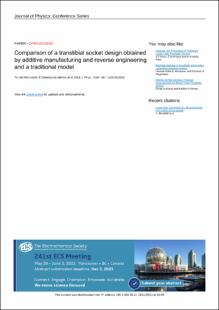Mostrar el registro sencillo del ítem
Comparison of a transtibial socket design obtained by additive manufacturing and reverse engineering and a traditional model
| dc.contributor.author | Prada Botia, Gaudy Carolina | |
| dc.contributor.author | Salamanca Jaimes, E | |
| dc.contributor.author | Rodrigues, P H | |
| dc.contributor.author | Reis, G | |
| dc.contributor.author | Campos Rubio, J C | |
| dc.contributor.author | Volpini Lana, M R | |
| dc.date.accessioned | 2021-11-18T17:02:42Z | |
| dc.date.available | 2021-11-18T17:02:42Z | |
| dc.date.issued | 2018-12-07 | |
| dc.identifier.uri | http://repositorio.ufps.edu.co/handle/ufps/1092 | |
| dc.description.abstract | The purpose of this article is to present manufacturing methodologies through reverse engineering of socket design for a transtibial amputee, bearing in mind that it is a customized product. In addition, the traditional manufacturing process will be arrived at in comparison with the model proposed. In this sense, this document proposes a new practical approach to modeling the contact interface, i.e. the prosthetic socket and the skin, and thus making a more functional prosthesis by helping people to visibly improve their quality of life. | eng |
| dc.format.extent | 07 páginas | spa |
| dc.format.mimetype | application/pdf | spa |
| dc.language.iso | eng | spa |
| dc.publisher | Journal of Physics: Conference Series | spa |
| dc.relation.ispartof | Journal of Physics: Conference Series | |
| dc.rights | © Copyright 2021 IOP Publishing | eng |
| dc.source | https://iopscience.iop.org/article/10.1088/1742-6596/1126/1/012016/meta | spa |
| dc.title | Comparison of a transtibial socket design obtained by additive manufacturing and reverse engineering and a traditional model | eng |
| dc.type | Artículo de revista | spa |
| dcterms.references | World Health Organization (WHO) 2013 World health statistics 2013: A wealth of information on global public health (Switzerland: World Health Organization) 109-115 | spa |
| dcterms.references | Nieto J, Carvajal M, Urriolagoitia G, Hernández H and Minor A 2003 Determinación de esfuerzos en el socket de una prótesis transtibial por medio del método del elemento finito Acta Ortopédica Mexicana 17 89-93 | spa |
| dcterms.references | Christoph R, Muñoz R and Hernández A 2016 Manufactura aditiva Realidad y Reflexión 43 98-109 | spa |
| dcterms.references | Wong K and Hernandez A 2012 A review of additive manufacturing ISRN Mechanical Engineering 2012 1-10 | spa |
| dcterms.references | Moussa A and Bashir M 2017 Additive manufacturing: A new industrial revolution – A review Journal of Scientific Achievement 2 19-31 | spa |
| dcterms.references | V-Niño E D, Endrino J L, Estupiñan H A, Pérez B and Díaz A 2016 Caracterización microscópica de texturas superficiales fabricadas aditivamente mediante estereolitografía láser Respuestas 21 37-47 | spa |
| dcterms.references | Martinez A, González O A and Martínez E 2017 Evaluación de las propiedades tribológicas de materiales compuestos de matriz metálica (MMCs) procesados por técnicas de fabricación aditiva con haz láser (SLM) Revista UIS Ingeniería 16 101-114 | spa |
| dcterms.references | Smith D 2004 Notes from the medical director: The knee disarticulation: It’s better when it’s better and it’s not when it’s not inMotion 14 56-62 | spa |
| dcterms.references | Pirouzi G, Osman A, Eshraghi A, Ali S, Gholizadeh H and Wan W 2014 Review of the socket design and interface pressure measurement for transtibial prosthesis Scientific World Journal 2014 1-9 | spa |
| dcterms.references | Kumar P and Choudhury A 2011 Analysis of transtibial prosthetic socket materials using finite element method Biomedical Science and Engineering 4 762-768 | spa |
| dcterms.references | Williams J, Adewunmi A, Schek R, Flanagan C, Krebsbach P, Feinberg S, Hollister S and Dasb S 2005 Bone tissue engineering using polycaprolactone scaffolds fabricated via selective laser sintering Biomaterials 26 4817-4827 | spa |
| dcterms.references | Seyed S, Gharehkhani S, Mehrali M, Yarmand H, Cornelis H, Kadri N and Abu N 2015 A review on powder-based additive manufacturing for tissue engineering: selective laser sintering and inkjet 3D printing Sci Technol Adv Mater 16 033502 | spa |
| dc.identifier.doi | https://doi.org/10.1088/1742-6596/1126/1/012016 | |
| dc.publisher.place | Reino Unido | spa |
| dc.relation.citationedition | Vol.1126 No.1.(2018) | spa |
| dc.relation.citationendpage | 7 | spa |
| dc.relation.citationissue | 1(2018) | spa |
| dc.relation.citationstartpage | 1 | spa |
| dc.relation.citationvolume | 1126 | spa |
| dc.relation.cites | Jaimes, E. S., Botía, G. P., Rodrigues, P. H., Reis, G., Rubio, J. C., & Lana, M. V. (2018, November). Comparison of a transtibial socket design obtained by additive manufacturing and reverse engineering and a traditional model. In Journal of Physics: Conference Series (Vol. 1126, No. 1, p. 012016). IOP Publishing. | |
| dc.relation.ispartofjournal | Journal of Physics: Conference Series | spa |
| dc.rights.accessrights | info:eu-repo/semantics/openAccess | spa |
| dc.rights.creativecommons | Atribución 4.0 Internacional (CC BY 4.0) | spa |
| dc.type.coar | http://purl.org/coar/resource_type/c_6501 | spa |
| dc.type.content | Text | spa |
| dc.type.driver | info:eu-repo/semantics/article | spa |
| dc.type.redcol | http://purl.org/redcol/resource_type/ART | spa |
| oaire.accessrights | http://purl.org/coar/access_right/c_abf2 | spa |
| oaire.version | http://purl.org/coar/version/c_970fb48d4fbd8a85 | spa |
| dc.type.version | info:eu-repo/semantics/publishedVersion | spa |










